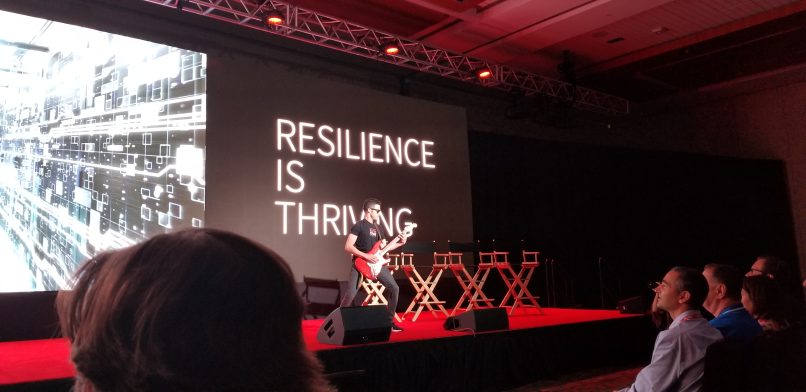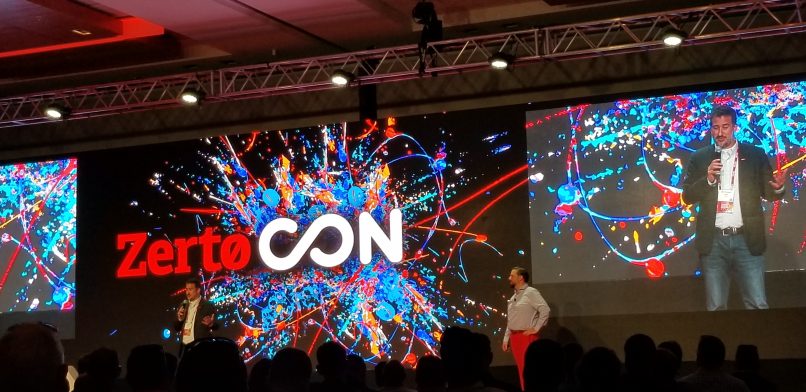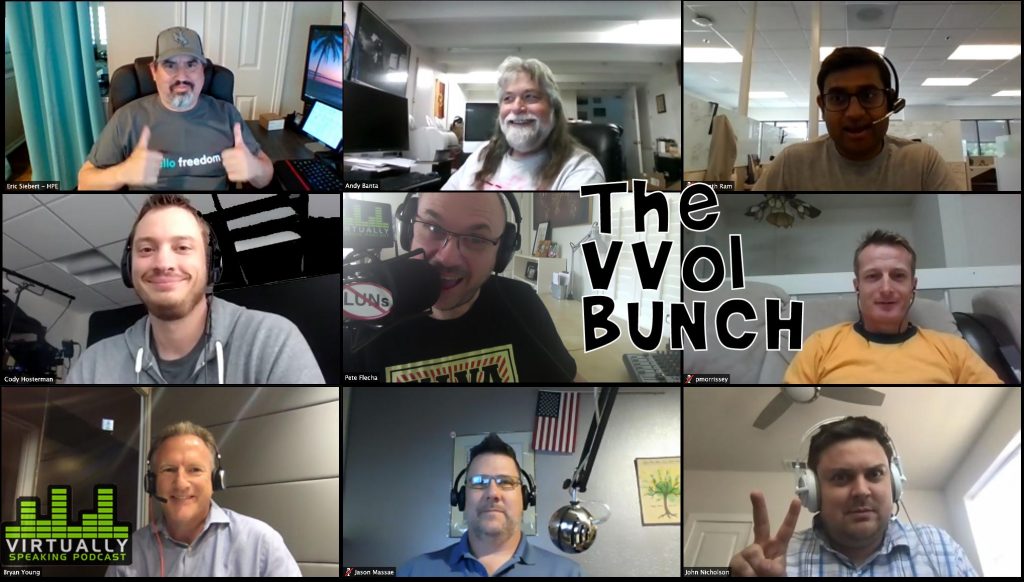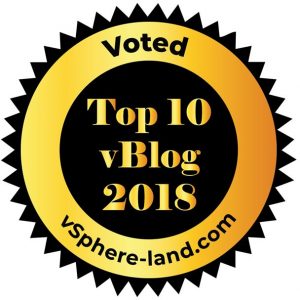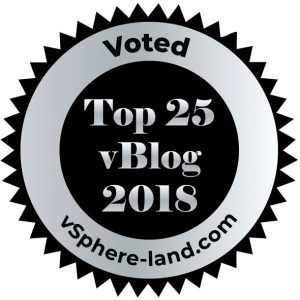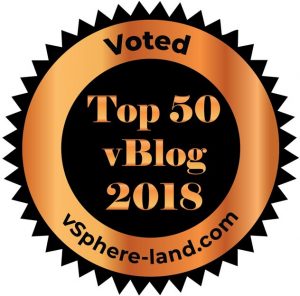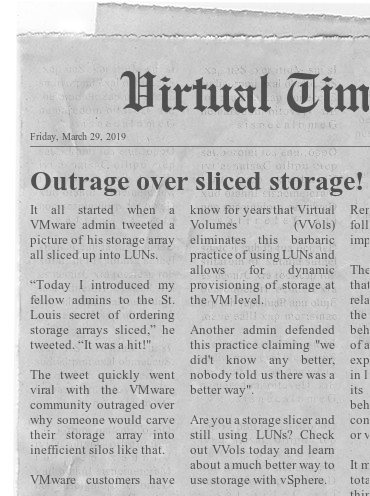Author's posts
Jun 03 2019
VMware releases new Photon OS based SRM appliance
Last year I wrote about the Photon OS based SRM appliance that was coming in the next big SRM release to replace the traditional Windows based model and now it’s finally here as part of SRM 8.2 that was released last month. My post from last year was based on the tech preview that VMware did at VMworld of the new appliance in the SRM session. I’ve been working closely with VMware on the SRM 8.2 release as the Product Manager for our 3PAR SRA so I’ve been pretty close to the engineering work that we had to do to transition from a Windows based SRA to a Linux based SRA that is deployed within a docker container.
Beginning with SRM 8.2 you can now deploy SRM a lot easier as a virtual appliance that is based on VMware’s Photon OS, so no more Windows. There are several benefits to this including cost savings (not licensing Windows), simplicity (easier install/manageability), security (less attack vectors) and consistency (pre-built appliance). The appliance uses Photon OS which runs the SRM server application and then a Docker instance for vendor specific SRA’s as you can see in the below figure.
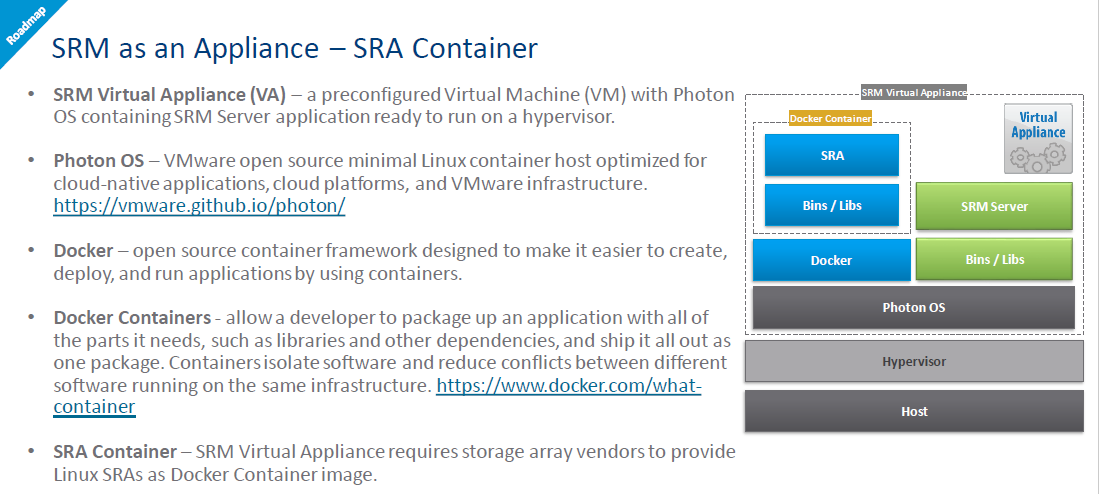 The specifications for SRA’s basically remains the same as their is no real functionality difference here with the only difference being mainly the packaging of the SRA. There is some new metadata requirements and entry point locations specific to commands, locations and permissions within the Docker container. The Docker images contain the vendor SRA application and all the libraries and dependencies that it needs to run on Linux.
The specifications for SRA’s basically remains the same as their is no real functionality difference here with the only difference being mainly the packaging of the SRA. There is some new metadata requirements and entry point locations specific to commands, locations and permissions within the Docker container. The Docker images contain the vendor SRA application and all the libraries and dependencies that it needs to run on Linux.
SRM 8.2 supports both the new Photon OS based virtual appliance and the existing Windows deployment models however I’ve heard that VMware is going to be pretty aggressive about deprecating the Windows version. For Windows SRA’s in 8.2 nothing really changes, storage array vendors should have SRA’s for both models with 8.2 but the same Windows SRA’s you previously used will work with 8.2. The process to install SRA’s is basically the same, download it from either the vendor or VMware site and then upload it inside the SRM interface.
The big question for existing SRM customers is how you will migrate from an existing Windows based SRM environment to the new Photon OS. To do an in place migration your Windows based SRM environment must be upgraded to the Windows based SRM 8.2 version. The only supported SRM versions to directly upgrade to SRM 8.2 are 6.5, 6.5.1, 8.1.1 and 8.1.2. If you are running SRM 6.1.2 you must first upgrade to SRM 8.1.1 and then to SRM 8.2. If you are running an a version older then 6.1.2 you must first upgrade to 6.1.2 before going to 8.1.1. This can result in a lot of upgrades to get to 8.2, you can see the supported upgrade paths by version at the VMware Product Interoperability Matrices which is also shown below.
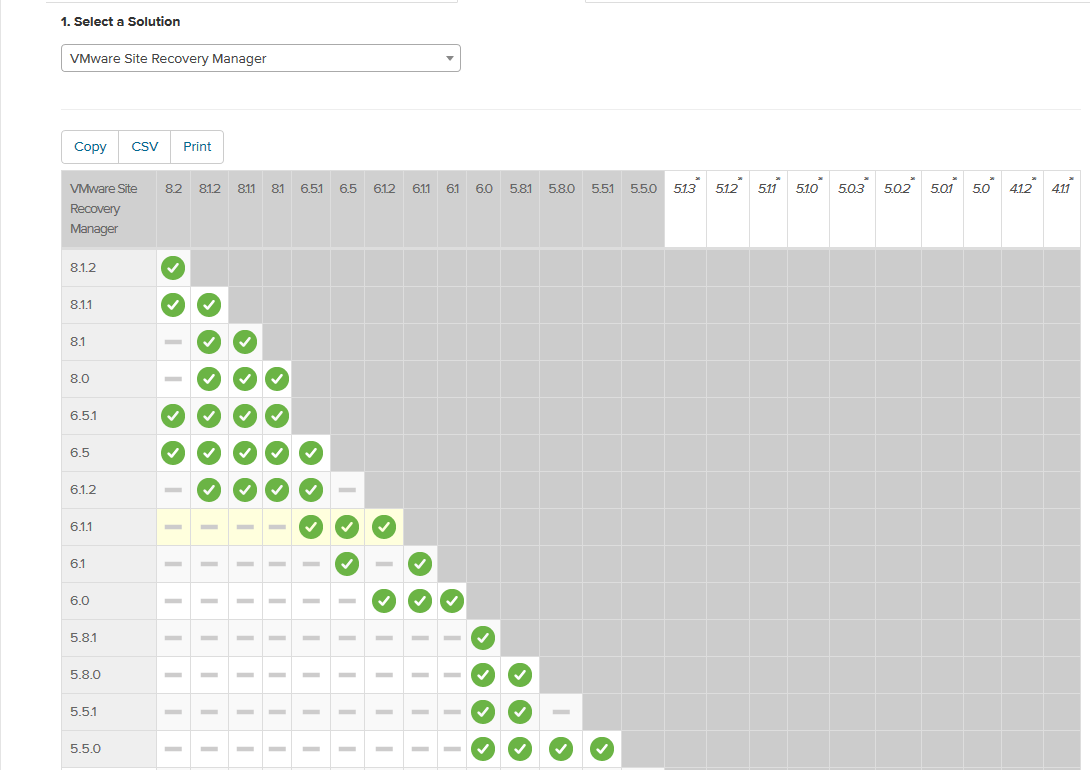 When you’re ready to upgrade read through the SRM 8.2 Installation and Configuration documentation which shows the steps once you have upgraded your Windows SRM to version 8.2. You will need to first deploy the Photon OS SRM virtual appliance and then you run some command line scripts to export your existing configuration data from Windows and then import it into the Photon OS appliance. Finally you need to install the new SRA’s and then reconnect it to the second site. You can optionally migrate back to the Windows SRM if something doesn’t work out by simply powering off the Photon OS appliance, powering back on the Windows SRM and then reconnecting to the second site.
When you’re ready to upgrade read through the SRM 8.2 Installation and Configuration documentation which shows the steps once you have upgraded your Windows SRM to version 8.2. You will need to first deploy the Photon OS SRM virtual appliance and then you run some command line scripts to export your existing configuration data from Windows and then import it into the Photon OS appliance. Finally you need to install the new SRA’s and then reconnect it to the second site. You can optionally migrate back to the Windows SRM if something doesn’t work out by simply powering off the Photon OS appliance, powering back on the Windows SRM and then reconnecting to the second site.
Before you upgrade though its very important you make sure your storage vendor support the Photon OS SRA, as of right now not many vendors do. You can check this at the SRM Compatibility Guide by selecting version 8.2 and it will then show an OS type in the listings (Windows/Photon) as show below. I know HPE 3PAR & Nimble both had day 0 support for Photon and taking a quick look right now it appears only 3 other vendors support it (Dell/EMC, Pivot3 & Pure). Also remember that 8.2 support doesn’t mean Photon support unless specifically indicated.
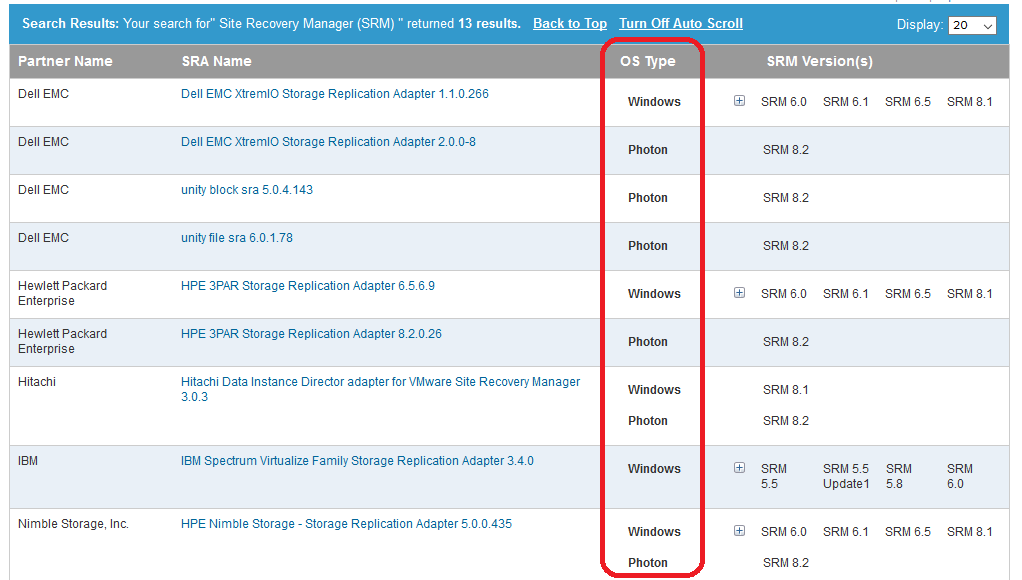 SRM 8.2 contains some additional enhancements as well which are shown below and I know VMware has worked very hard on this release as they prepare to take on VVols support next.
SRM 8.2 contains some additional enhancements as well which are shown below and I know VMware has worked very hard on this release as they prepare to take on VVols support next.
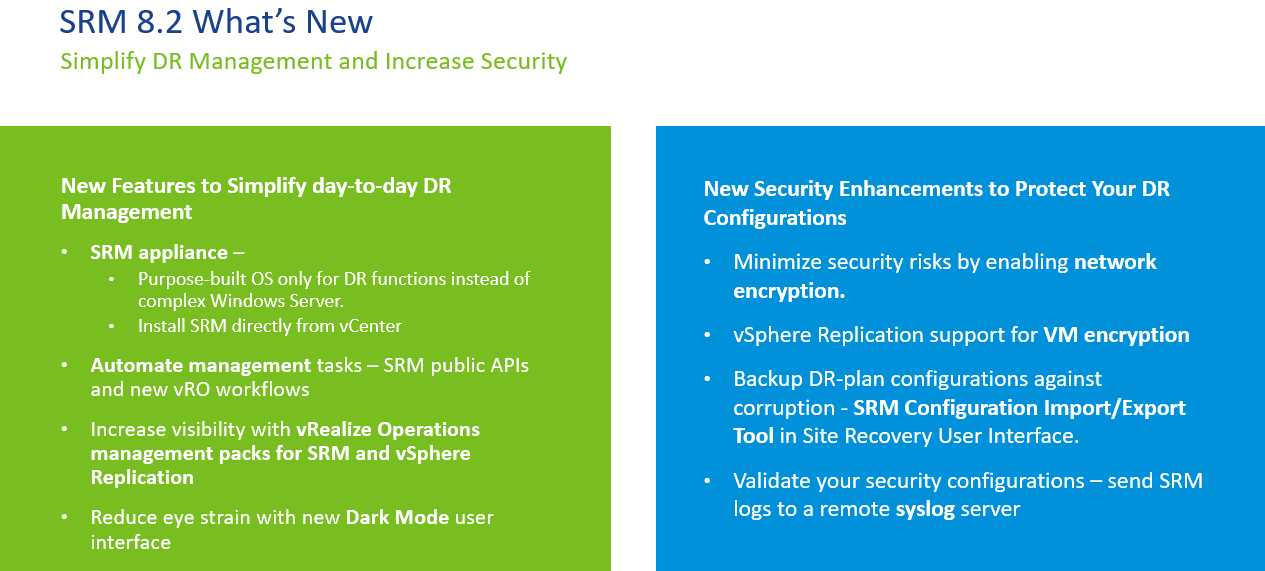 Below are some additional links to help get you started with the new SRM 8.2 Photon OS based virtual appliance.
Below are some additional links to help get you started with the new SRM 8.2 Photon OS based virtual appliance.
- Introducing VMware Site Recovery Manager 8.2 (Virtual Blocks blog)
- VMware Site Recovery Manager 8.2 Release Notes (VMware docs)
- SRM 8.2 Installation and Configuration (VMware docs)
- What’s New in SRM 8.2 (VMware #StorageMinute video)
- Getting the most out of the new SRM 8.2 Appliance – Upgrading, Migration and more (Virtual Blocks blog)
- An introduction to VMware SRM 8.2 & HPE Nimble Storage SRA 5.0.0 (HPE Storage blog)
- Photon-based SRM 8.2 and Pure (Cody Hosterman)
- VMware SRM 8.2 is here with XtremIO SRA AND point in time failover support (Itzikr’s Blog)
Jun 02 2019
ZertoCON 2019 takeaways: a close family, Zerto 7 and a bright future
When Zerto invited me as their guest to attend ZertoCON 2019, I thought about it briefly and then told them yes I’d love to attend. The only conferences I have ever attended have been VMworld, HPE Discover and VMUG events and I thought it would be good to broaden my exposure and see the world of virtualization from other partners perspectives. After confirming my attendance I packed my bags and headed to Nashville for 3 days at ZertoCON.
 This was my first time in Nashville and I knew it was famous for it’s music. The conference was downtown at the Music City Center and and lively Broadway St which is lined with bars and reminded me very much of Bourbon St. in New Orleans. The Welcome Reception was at the nearby Country Music Hall of Fame and the event party was held at Blake Shelton’s bar Ole Red on Broadway St.
This was my first time in Nashville and I knew it was famous for it’s music. The conference was downtown at the Music City Center and and lively Broadway St which is lined with bars and reminded me very much of Bourbon St. in New Orleans. The Welcome Reception was at the nearby Country Music Hall of Fame and the event party was held at Blake Shelton’s bar Ole Red on Broadway St.
I’ll admit going into the event I didn’t know much about the Zerto product beyond it was a host-based replication product for VMware environments. Unlike other backup products that try and combine backup and replication into one product, Zerto has a single focus to provide near synchronous replication to a target site with very low RTO/RPO’s (CDP). As a result Zerto doesn’t necessarily replace your traditional backup solution which most companies use for long term retention, instead it adds a layer of resiliency on top of that for quicker recovery of an entire virtual environment or just parts of it (VM/files).
Before I go into what I learned about the the product, I’d like to start off by commenting about the people that work at Zerto. After spending 3 days with them I had the overwhelming sense that these weren’t just employees working together and collecting a paycheck but instead a very close tight knit family who very much enjoy their jobs. Everyone I met and talked to at Zerto was very friendly, I didn’t sense any attitudes and everyone was very approachable all the way up to the the senior VP of product, Rob Strechay (an old friend) and the CEO, Ziv Kedem who actually had his father and daughter in attendance at the show.
Unlike larger companies where the CEO and officers are usually withdrawn and occasionally make appearances at events. At ZertoCon all the VP’s and the CEO were everywhere from socializing with everyone during the event to hanging out at the parties and after parties and acting just like one of the guys (or gals). I had a Zerto customer sitting next to me at one of the event keynotes and he commented about the CEO sitting right in front of us and how he was shocked he didn’t have a security detail. I explained that Zerto started out as a very small company (3 employees) and to me they have retained that small company atmosphere despite being over 700 employees now.
The keynote kicked off with Zerto’s CEO, Ziv describing Zerto’s journey starting off with 3 employees in 2009 to 750 employees, 7,000 customers and 1,000 partners today. He covered some news around a new subscription pricing model, the launch of Zerto 7, as well as some key partnerships with HPE and VMware. He also highlighted some of their biggest customers such as United Airlines and some healthcare companies and talked about the value that Zerto was bringing to those companies. I saw references to many healthcare companies during ZertoCON which reinforces the value prop of high resiliency that Zerto brings to those critical care customers that cannot afford any downtime.
 The partnership with HPE centered around Zerto’s goal of extending their protection to be long term to offer additional value to customers and try and become both a backup and DR solution. This is important as most companies have long term retention needs especially due to regulations and if Zerto can cover that it eliminates the need to have a separate backup product for LTR purposes. As a result they are providing support for secondary storage and backup appliances like HPE’s StoreOnce product.
The partnership with HPE centered around Zerto’s goal of extending their protection to be long term to offer additional value to customers and try and become both a backup and DR solution. This is important as most companies have long term retention needs especially due to regulations and if Zerto can cover that it eliminates the need to have a separate backup product for LTR purposes. As a result they are providing support for secondary storage and backup appliances like HPE’s StoreOnce product.
I felt the partnership with VMware is a critical one as it has everything to do with how Zerto taps into the VM I/O stream to replicate data. To date Zerto has used a kernel module that sits inline in the vSCSI stack between a VM and the physical I/O device so it has access to the data to replicate it. This vSCSI filter has access to all reads and writes to/from a VM and is completely transparent to the VM and basically just sends whatever data is needed to replicate to the target device. While this works just fine, I’ve heard that it’s not the way VMware wants it’s partners to access data anymore and the preferred way is to use the vSphere API’s for I/O filtering that were introduced in vSphere 6.
VAIO is a new I/O framework that taps into data right below the vSCSI device layer of a VM in the user world space which sits above the kernel world of the hypervisor. It allows for certain types of 3rd party filters such as caching, security and replication to be supported via policy based management. So essentially the end result is the same but the data tap moves out of the kernel world and into the user world and provides a supported method for partners to access I/O without potentially endangering the vmkernel. This is VMware’s preferred method as they have stated that using the kernel method was never a way to access data intended by engineering. To help reinforce this new support Zerto had VMware’s Michael Adam’s on stage to talk about the partnership with Zerto. You can read more about VAIO in this VMware blog post.
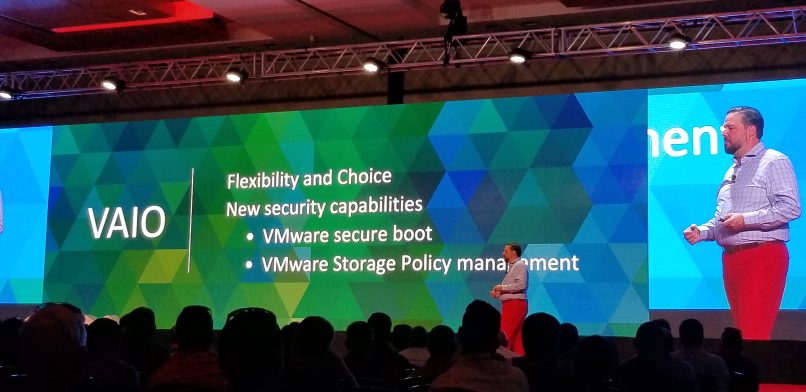 Support for VAIO is not available today in Zerto 7 and they have indicated that they have completed the initial certification for VAIO and it should be available as part of Zerto 7.5 which is planned for later this year in the 2nd half of 2019.
Support for VAIO is not available today in Zerto 7 and they have indicated that they have completed the initial certification for VAIO and it should be available as part of Zerto 7.5 which is planned for later this year in the 2nd half of 2019.
One last note on VAIO before I move on which has to do with my favorite topic, VVols. I had heard that Zerto did not support VVols which had surprised me as I thought host based replication products should work just fine with VVols as they replicate at the host level and not the array level. Apparently though the way they tap into data at the kernel level does not work with VVols, however once they make the switch to VAIO presumably this should work OK and they should have VVols support.
So VAIO is the future for Zerto, let’s now talk about the recently released Zerto 7. I mentioned earlier that the main use case for Zerto is short term BC/DR up to about 30 days of recovery. A big focus of Zerto 7 was to extend that out to have longer term repositories to essentially transform Zerto into being both a backup and BC/DR product. Zerto 7 uses a new elastic journal that combines granular short term recovery points with longer term repositories so customers can recover data whether its from seconds ago or years ago. This satisfies the long term retention requirements that most customers have and makes Zerto a candidate for primary backup which eliminates the need for a separate backup application.
To achieve LTR Zerto currently supports storing data on external network attached storage repositories such as purpose-built backup appliances such as HPE StoreOnce or network shares using the NFS or SMB file protocols. Optionally customers can also use Azure Databox Edge and AWS Storage Gateway to utilize a cloud storage as a backup target.
Zerto 7 also features a new advanced cloud-based analytics platform that runs in the cloud so there is nothing to install or configure to utilize it, data is sent automatically from on premise to the cloud analytics platform. This allows customers to see both real-time and historical insights into the health and protection status of everything protected by Zerto to help spot trends, anomalies and issues. In addition there is also a resource planner which allows customers to monitor resources and create what-if scenarios for planning purposes.
There are a lot more enhancements and features in Zerto 7, you can read the full list of what’s new in Zerto 7 here, also there is a FAQ document available to help answer any questions about Zerto 7.
One of the keynotes at ZertoCON featured Peyton Manning, a player I know all to well as he lead my Denver Broncos to a Super Bowl championship. As a result I was excited to see him and hear him talk about his life, football career, leadership and of course resiliency. The keynote was an interview style where he answered questions from one of the Zerto VP’s. One of his stories centered around him being the new guy on the team after being drafted as the #1 pick and trying to find his place as a leader on the team. It didn’t quite go as anticipated and as he liked to point out that the team getting the #1 pick has earned the right to have that pick (hint, worse team in the league).
One of the biggest takeaways I came away with was a story and great life advice as he told about getting drafted and signing his first big contract, when he was asked by the press afterwards about what he was going to do with all that money he replied “I’m going to earn it”. That really reinforces his work ethic and not expecting to have things handed to him without a strong commitment to give 100% to his employer and team. The entire interview was pretty fascinating to listen to especially for a football fan and afterwards we were able to meet him in person and take a picture with him at the event party.
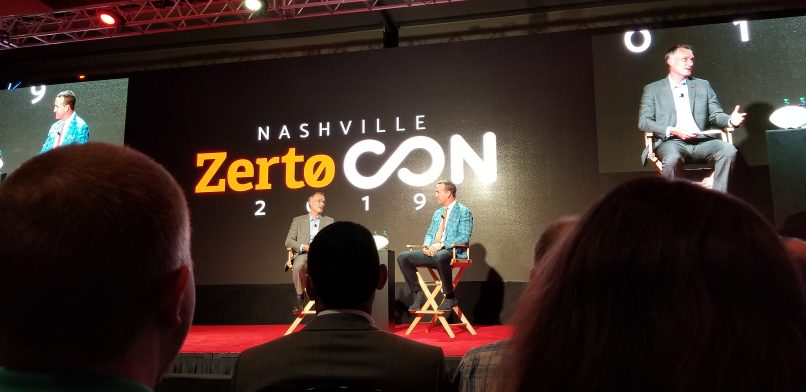 Zerto also gave a great glimpse into their future product direction at ZertoCON, the product has really evolved since it’s initial release in 2011 and Zerto looks to build on that success. The short term roadmap included support for VAIO, LTR backup appliances and continued analytics enhancements. More longer term Zerto plans on introducing a next generation core platform and even more expansion into cloud with support for Google Cloud and support for containerized platforms like Docker and Kubernetes.
Zerto also gave a great glimpse into their future product direction at ZertoCON, the product has really evolved since it’s initial release in 2011 and Zerto looks to build on that success. The short term roadmap included support for VAIO, LTR backup appliances and continued analytics enhancements. More longer term Zerto plans on introducing a next generation core platform and even more expansion into cloud with support for Google Cloud and support for containerized platforms like Docker and Kubernetes.
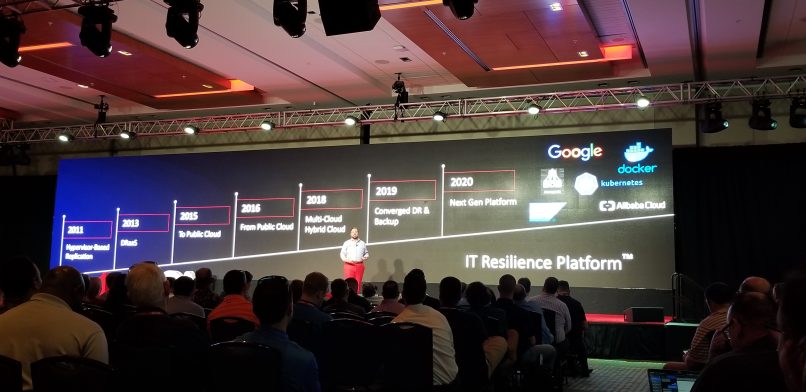 ZertoCON wasn’t just all work, Zerto did a great job ensuring attendees had plenty of fun at the event. The kick off party at the Country Music Hall of Fame was a great way to network with attendees, partners and Zerto folks. We also had an informal community after party with some of the vExperts in attendance and Fara Hain, Carly Oberdoerster and Kaitlyn McCullough from Zerto which was a lot of fun. The official event party was held at Blake Shelton’s bar Ole Red on Broadway street. They had a fantastic and fun country band there, Hoss Skelton, who was very interactive with the attendees. There was also a few late night after parties at Tootsies down the street that featured 3 floors of bands playing there.
ZertoCON wasn’t just all work, Zerto did a great job ensuring attendees had plenty of fun at the event. The kick off party at the Country Music Hall of Fame was a great way to network with attendees, partners and Zerto folks. We also had an informal community after party with some of the vExperts in attendance and Fara Hain, Carly Oberdoerster and Kaitlyn McCullough from Zerto which was a lot of fun. The official event party was held at Blake Shelton’s bar Ole Red on Broadway street. They had a fantastic and fun country band there, Hoss Skelton, who was very interactive with the attendees. There was also a few late night after parties at Tootsies down the street that featured 3 floors of bands playing there.
 I’m really glad I attended the event, it really opened my eyes to Zerto’s product and the BC/DR world which I didn’t know much about until I attended ZertoCON. Nashville was a great venue for the event which was very well integrated to the country music theme that Nashville is known for. Special thanks to Kaitlyn for the invitation and helping with all the logistics, Carly, Fara and my buddy Rob Strechay who were fun to hang out with and Gijsbert for spending time answering all my deep technical questions.
I’m really glad I attended the event, it really opened my eyes to Zerto’s product and the BC/DR world which I didn’t know much about until I attended ZertoCON. Nashville was a great venue for the event which was very well integrated to the country music theme that Nashville is known for. Special thanks to Kaitlyn for the invitation and helping with all the logistics, Carly, Fara and my buddy Rob Strechay who were fun to hang out with and Gijsbert for spending time answering all my deep technical questions.
My key takeaways from the event are an overwhelming sense of what a close and tight family Zerto is and how they have maintained a start-up/small company atmosphere despite growing as large as they have. They made me feel very welcome there and all the customers I saw and heard from seemed very loyal to Zerto. I learned a lot about how Zerto works under the covers and how Zerto has evolved into what it is today with Zerto 7 and the convergence of backup and BC/DR. I also learned the answer to my burning question on why Zerto doesn’t support VVols and saw a glimpse of their future which looks very bright indeed. I feel Zerto is making all the strategic moves that they need to be a very competitive player in the data protection industry as more companies look towards cloud options and I think they are guaranteeing they will be successful in the long term.
 Disclaimer: Zerto did pay for my travel to ZertoCON but these are my honest and unbiased opinions and experiences from the event.
Disclaimer: Zerto did pay for my travel to ZertoCON but these are my honest and unbiased opinions and experiences from the event.
You can get a very brief glimpse of ZertoCON here: Day 1 video, Day 2 video and Day 3 video
Some additional pics from ZertoCON:
Opening reception at the Country Music Hall of Fame:
 My good friend Alastair Cooke talking about vBrownBag and community:
My good friend Alastair Cooke talking about vBrownBag and community:
 A rocking kickoff to the ZertoCON keynote:
A rocking kickoff to the ZertoCON keynote:
 Peyton wanted to take a picture with a vExpert so I said OK but no autographs:
Peyton wanted to take a picture with a vExpert so I said OK but no autographs:
 Rocking Broadway St. with the AT&T Eye of Suaron tower overshadowing:
Rocking Broadway St. with the AT&T Eye of Suaron tower overshadowing:
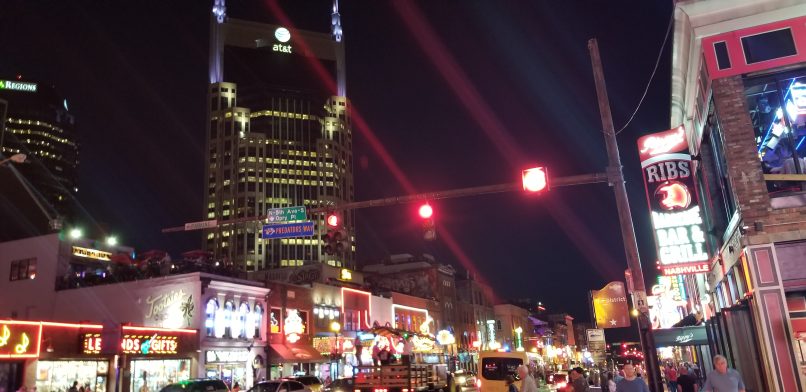 Another view of Broadway St. with Tootsies on the left:
Another view of Broadway St. with Tootsies on the left: VMware’s Mike Adams stops by to reinforce the partnership with Zerto:
VMware’s Mike Adams stops by to reinforce the partnership with Zerto:
May 24 2019
4 out of 5 storage partners surveyed would recommend VVols for their customers who use VMware
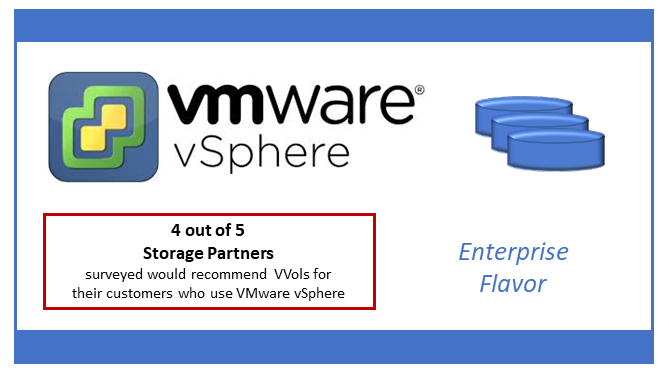 Remember the old Trident gum commercial, it was a ringing endorsement from dentists for their patients that chew gum. Well recently VMware hosted a Virtually Speaking podcast featuring various storage partners to talk about VVols. The podcast featured representatives from key VVols partners: HPE, Pure, HDS and NetApp along with Bryan Young (VVols product manager), Pete Flecha, John Nicholson and Jason Massae from VMware.
Remember the old Trident gum commercial, it was a ringing endorsement from dentists for their patients that chew gum. Well recently VMware hosted a Virtually Speaking podcast featuring various storage partners to talk about VVols. The podcast featured representatives from key VVols partners: HPE, Pure, HDS and NetApp along with Bryan Young (VVols product manager), Pete Flecha, John Nicholson and Jason Massae from VMware.
I happened to be one of the people representing HPE and we talked about various topics including adoption and how customers are using VVols. When it comes to adoption both VMware and all partners are seeing increasing customer usage of VVols and every partner recommends that customers check out VVols and see what they are missing out on. So go listen to the podcast here, and what about that 5th partner? Apparently they didn’t show up but I’m confident they would recommend VVols to their customers as well.
May 14 2019
Top vBlog 2018 logos now available for the Top 50 blogs
I had logos made again this year for the blogs that made the top 50 in Top vBlog that you can display on your website. It’s always a crap shoot using Fiverr on how well the designer does, this year they turned out OK but was hoping they would be a bit better. You can download the individual logos below and size them however you need to fit on your site. Enjoy and congrats to all who made the top 50!.
Apr 01 2019
VMware quietly introduces support for FC external block storage with VCF
From it’s initial launch VMware Cloud Foundation (VCF) has been an all VMware software-defined stack powered by vSAN for both the management and workload storage domains. Customers that wanted to add additional storage were limited to only using vSAN as the solution didn’t allow for support of external storage devices to be used with VCF. That changed when VMware introduced version 3.5 of VCF late last year, with 3.5 supported storage was extended to include external NFS storage devices but only for workload domain storage. VMware described this new support in a blog post:
[important]”VCF now supports creation of a Workload Domain on NFS 3.0 Storage. Although VSAN is the preferred storage platform for VMware and Cloud Foundation, we recognize that many customers have existing investments in NFS 3.0 storage that they would like to continue to leverage. With NFS support customers can continue utilizing their investments in NFS as they begin their Cloud Foundation journey.”[/important]
A look at the VCF 3.5 FAQ document also confirms support and specifically states the following in the storage section:
- Q. Is vSAN required with Cloud Foundation? A. vSAN is the required primary storage for the management domain.You can deploy VI workload domains without vSAN and use external NFS storage instead.
- Q. Can I use Network Attached Storage (NAS) with Cloud Foundation? A. Yes, you can create VI workload domains with external NFS storage. iSCSI storage can be connected manually.
- Q. Can I use FCoE or Fibre Channel with Cloud Foundation? A. No, FCoE and Fibre Channel are not supported with Cloud Foundation.
The FAQ states that both NFS & iSCSI storage are supported with VCF in 3.5, the difference between the support of those protocols is that NFS storage supports automatic provisioning of storage as opposed to iSCSI storage which must be manually provisioned. The reason for that is NFS storage can be managed within the SDDC Manager interface and iSCSI cannot presumably because it can’t deal with LUN management. Support for Fibre Channel storage is specifically called out as not support presumably as it is not network based storage and you have additional configuration overhead with zoning.
As of recently VMware now officially supports using FC storage with VCF as well with the caveat that no automation is supported like it is with NFS storage and it must be manually provisioned and managed out of band. FC is supported starting with the VCF 3.5.1 release, which also includes version 3.7 which was just released. As far as I know VMware has not made any announcement around this new support, I found out through meetings with the VCF product manager at VMware who said it was OK for partners to make announcements about it. Again support for FC storage is limited to the workload domain as only vSAN can be used for the management domain storage.
You’ll notice that there is no special HCG listing for supported storage with VCF, basically any storage that works with vSphere is supported although it is up to each partner to do some basic validation that their storage platforms work OK with VCF. With NFS storage it can be managed automatically in band as demonstrated in this demo video. With block storage (FC/iSCSI) it must be managed manually and out of band. VMware does look to extend automation to block storage as well at some point by leveraging Virtual Volumes (VVols) which automates storage provisioning at the VM level through policy based management and eliminates the need for LUN management.
It’s good to see VMware extending their VCF stack to support external storage which benefits both customers and partners and allows more flexibility when deploying VCF. It’s also good to see another use case for VVols as it shares the same policy based management framework with vSAN and they are fully interoperable with each other. You can learn more about VMware Cloud Foundation on the VMware website and I suspect at some point VMware will publish acknowledge of the new FC support somewhere.
Mar 29 2019
What do bagels and storage arrays have in common? Neither should be sliced!
To set the context for this if you haven’t seen it, recently there has been a lot of public outrage all over the internet about someone ordering bagels sliced up like bread. You can read all about this controversy here, having read that myself I naturally thought of the comparison to storage in VMware environments. The result is the newspaper article below, enjoy and happy Friday!
Mar 25 2019
VMworld 2019 Call For Papers, I mean Case Studies, is now open
The annual call for content for VMworld is now open through April 16th, however this year VMware has changed the submission process and is basically only looking for customer case studies. Instead of the old form where you did an abstract, outline and key takeaways on whatever topic you wanted, now you fill out a simple speaker interest form where you enter your name, title and how many case studies you want to submit (2 max) and then you fill in the following:
- What problem(s) did you or your customer face?
- On which solution(s) did you decide?
- How did you implement those solution(s)?
- What factors contributed to your or your customer’s success or failure?
VMware has made this change to “lighten the submission load”, if you read into that it sounds like VMware wants to limit the submissions to be only case studies which will greatly reduce the amount of sessions they need to review (and ultimately reject). As a result this basically excludes the traditional deep dives, panels and other technical types of sessions that were popular in years past.
The good ole days were you had a decent shot of getting a session through have been gone for many years. VMware’s own sessions dominate the session catalog these days and if you want to get a session you have to pretty much buy one through a sponsorship. It’s a shame as there is a whole community full of people that have valuable knowledge to contribute. To a lesser degree they have a platform in social area of VMworld but it would be nice if VMware dedicated some session slots to community content. Below are the types of speaking opportunities available this year:
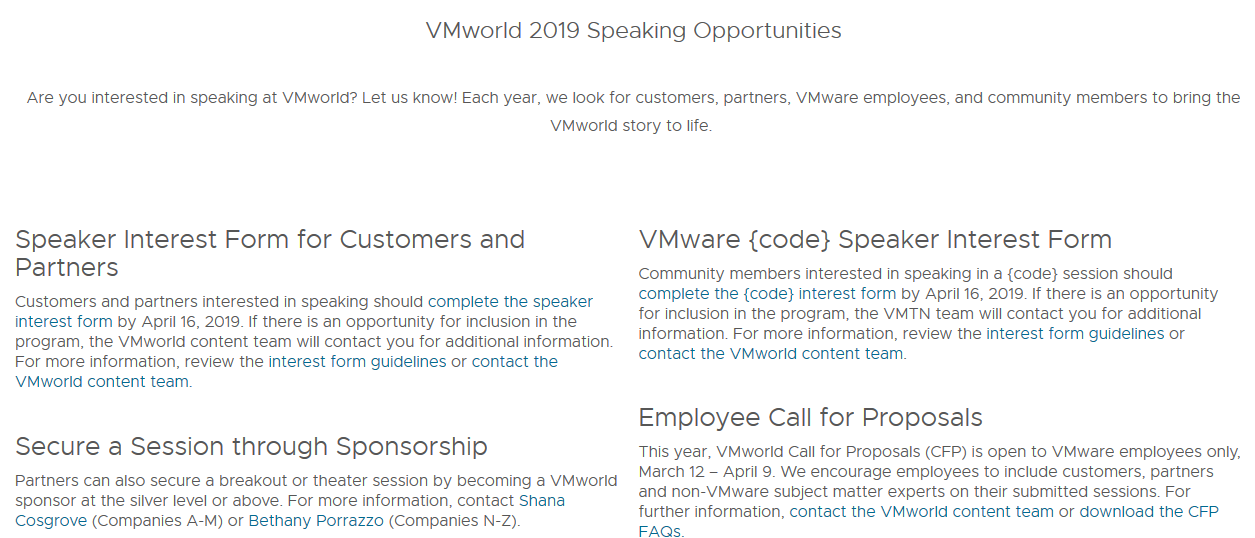 I may try and submit one on VVols as case studies are sorely needed to promote it, but finding customers able and willing to participate is always a challenge. If any HPE customers are using VVols and are interested in presenting please let me know and I’ll work with you to submit a request. And for those that want to try and submit a session request you can go fill out either the general speaker interest form or the {code} speaker interest form. The links to submit and guidelines are available in this form.
I may try and submit one on VVols as case studies are sorely needed to promote it, but finding customers able and willing to participate is always a challenge. If any HPE customers are using VVols and are interested in presenting please let me know and I’ll work with you to submit a request. And for those that want to try and submit a session request you can go fill out either the general speaker interest form or the {code} speaker interest form. The links to submit and guidelines are available in this form.
Mar 23 2019
Pat Gelsinger’s vInk re-visited
Remember the whole unveiling of Pat Gelsinger’s tattoo at VMworld last year? There was a lot of speculation on if it was real (permanent) or not (temporary). I was hanging out with Pat at the vExpert party were he rolled up his sleeve and showed it to us and couldn’t tell. I also did a post on it last year and laid out some evidence that it may have not been a permanent tattoo which is what I had suspected. I have never heard him confirm or deny that it was a permanent tattoo, but recently in an interview with CRN he confirmed it was a long term temporary tattoo:
So I’m giving the keynote that it was fun and there was great energy in the room. After the keynote, I’m running around like crazy. I call my wife at 9:30 p.m. that night. The only thing she said to me is, ‘You better have gotten rid of it before we go on vacation.’ There was nothing like, ‘Great keynote, honey. How are you doing?’ – no, it was, ‘You have better gotten rid of it before vacation.’ It was one of those long-term temporary tattoos. It’s successfully been eradicated from me. We did go on vacation and my wife still loves me and is married to me.
So there you have it, no more tattoo, but despite it being gone I’m sure his devotion to VMware remains unchanged. Maybe this year he’ll do something else crazy like shave his head or something.


